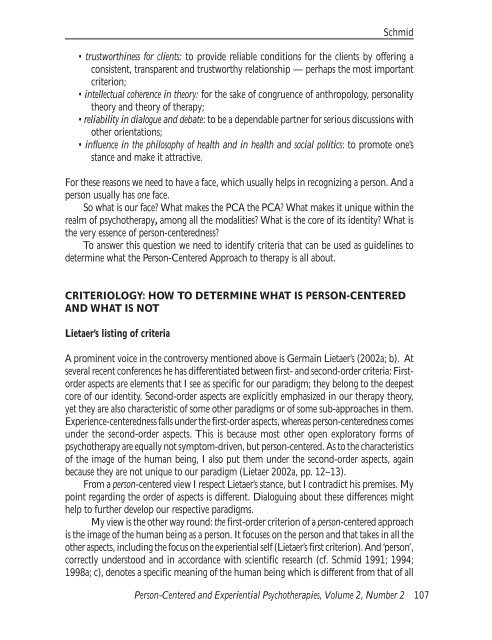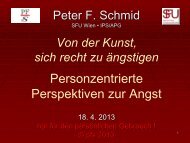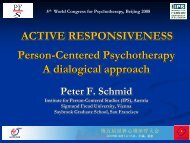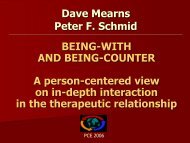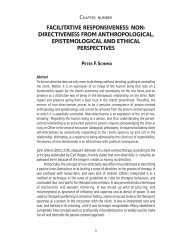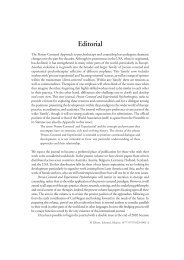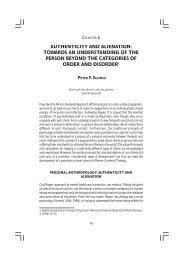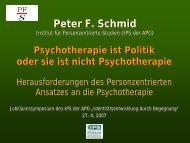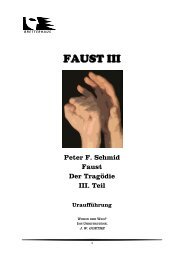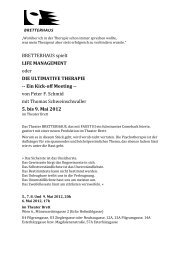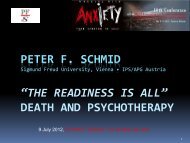The Characteristics of a Person-Centered ... - Peter F. Schmid
The Characteristics of a Person-Centered ... - Peter F. Schmid
The Characteristics of a Person-Centered ... - Peter F. Schmid
- No tags were found...
Create successful ePaper yourself
Turn your PDF publications into a flip-book with our unique Google optimized e-Paper software.
<strong>Schmid</strong>• trustworthiness for clients: to provide reliable conditions for the clients by <strong>of</strong>fering aconsistent, transparent and trustworthy relationship — perhaps the most importantcriterion;• intellectual coherence in theory: for the sake <strong>of</strong> congruence <strong>of</strong> anthropology, personalitytheory and theory <strong>of</strong> therapy;• reliability in dialogue and debate: to be a dependable partner for serious discussions withother orientations;• influence in the philosophy <strong>of</strong> health and in health and social politics: to promote one’sstance and make it attractive.For these reasons we need to have a face, which usually helps in recognizing a person. And aperson usually has one face.So what is our face? What makes the PCA the PCA? What makes it unique within therealm <strong>of</strong> psychotherapy, among all the modalities? What is the core <strong>of</strong> its identity? What isthe very essence <strong>of</strong> person-centeredness?To answer this question we need to identify criteria that can be used as guidelines todetermine what the <strong>Person</strong>-<strong>Centered</strong> Approach to therapy is all about.CRITERIOLOGY: HOW TO DETERMINE WHAT IS PERSON-CENTEREDAND WHAT IS NOTLietaer’s listing <strong>of</strong> criteriaA prominent voice in the controversy mentioned above is Germain Lietaer’s (2002a; b). Atseveral recent conferences he has differentiated between first- and second-order criteria: Firstorderaspects are elements that I see as specific for our paradigm; they belong to the deepestcore <strong>of</strong> our identity. Second-order aspects are explicitly emphasized in our therapy theory,yet they are also characteristic <strong>of</strong> some other paradigms or <strong>of</strong> some sub-approaches in them.Experience-centeredness falls under the first-order aspects, whereas person-centeredness comesunder the second-order aspects. This is because most other open exploratory forms <strong>of</strong>psychotherapy are equally not symptom-driven, but person-centered. As to the characteristics<strong>of</strong> the image <strong>of</strong> the human being, I also put them under the second-order aspects, againbecause they are not unique to our paradigm (Lietaer 2002a, pp. 12–13).From a person-centered view I respect Lietaer’s stance, but I contradict his premises. Mypoint regarding the order <strong>of</strong> aspects is different. Dialoguing about these differences mighthelp to further develop our respective paradigms.My view is the other way round: the first-order criterion <strong>of</strong> a person-centered approachis the image <strong>of</strong> the human being as a person. It focuses on the person and that takes in all theother aspects, including the focus on the experiential self (Lietaer’s first criterion). And ‘person’,correctly understood and in accordance with scientific research (cf. <strong>Schmid</strong> 1991; 1994;1998a; c), denotes a specific meaning <strong>of</strong> the human being which is different from that <strong>of</strong> all<strong>Person</strong>-<strong>Centered</strong> and Experiential Psychotherapies, Volume 2, Number 2 107


